This is a series of Neotibicen canicularis Northern Dog-Day cicada photos from Lakewood, NJ taken by Elias Bonaros.
Click the photos for larger versions:
A recently molted male Neotibicen canicularis cicada:
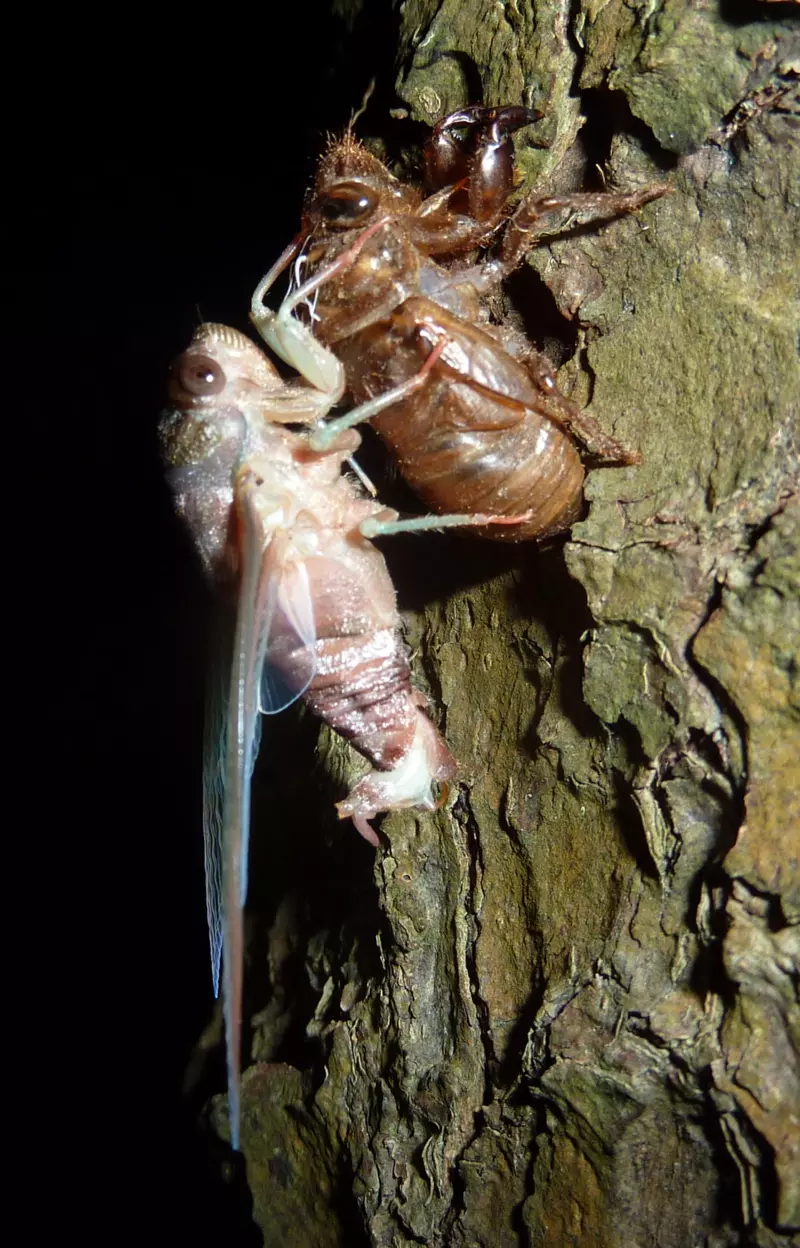
This is a series of Neotibicen canicularis Northern Dog-Day cicada photos from Lakewood, NJ taken by Elias Bonaros.
Click the photos for larger versions:
A recently molted male Neotibicen canicularis cicada:

Davis provided a key of cicadas that belong to the then genus Tibicen in his 1918 article Mississippi Cicadas, with a Key to the Species of the Southeastern United States from volume 26 of the Journal of The New York Entomological Society. Download it from archive.org. This guide works for the Northeast and Midwest as well.
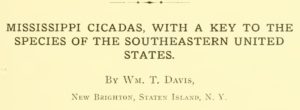
Since 1918, genus and some species names have changed, so I’m going to present the key here, with highlighted notes on the updated names + images (when I have them). I’ll try to replicate the formatting of the original document as best I can.
Here goes…
Note: the cicadas in the key are now organized in three genera: Neotibicen (A B), Megatibicen (A BB), and Diceroprocta (AA).
A. Large, heavy-bodied species; head broad, uncus [male genitals] simple, and first cross vein in the fore wings starting from radius 3 far back or about one-third distant from base of the first marginal cell.
B. Uncus longer than broad. Black species with green or greenish markings and black area on the central part of the abdomen beneath, except in sayi [sayi = Neotibicen tibicen tibicen], and new variety of davisi [new variety of davisi = Neotibicen davisi harnedi].
Note: this group of cicadas (B) are now organized under the genus Neotibicen, not Tibicen.
C. Hind margin of pronotum or collar, green or greenish.
A narrow irregular area of black on the under side of the abdomen; opercula short and broad, and usually in the males an attenuated, pruinose [frosty white] stripe each side on the dorsum of segment three … pruinosa (Say). [pruinosa = Neotibicen pruinosus pruinosus].
Dorsum of abdomen with the hind margin of the segments more or less brown and generally but a trace of pruinose stripe each side on segment three … pruinosa var. winnemanna (Davis) [pruinosa var. winnemanna = Neotibicen winnemanna].
[Generally speaking, east of the Appalachian mountains, you’ll find Neotibicen winnemanna, and west, it’s Neotibicen pruinosus.]
Dorsum of abdomen shining black with a broad pruinose mark each side on segment three; blackened area on under side of abdomen more in the nature of an even stripe … pruinosa var latifasciata (Davis) [pruinosa var. latifasciata = Neotibicen latifasciatus].
A longitudinal band of black on the under side of the abdomen, the opercula more lobate, and the margin of the front wings suddenly bent near the middle … linnei (Smith & Grossbeck) [linnei = Neotibicen linnei].
A definite longitudinal band of black on the under side of the abdomen; head with the front rather prominent. Not a large species … canicularis (Harris) [canicularis = Neotibicen canicularis].
An irregular band of black on the under side of the abdomen, head rounded in front; a rather small species … davisi (Smith & Grossbeck) [davisi = Neotibicen davisi davisi].
Abdomen greenish centrally on under side, blackened area wanting, marginal cells of fore wings clouded … davisi var. harnedi new variety [davisi var. harnedi = Neotibicen davisi harnedi].
CC. Hind margin of pronotum or collar black or nearly so (except in sayi var. australis).
D. Central area of the abdomen beneath black.
Opercula long and with the legs usually somewhat chest- nut colored ; the uncus when seen in profile forked, resembling the open mouth of a snake … similaris (Smith & Grossbeck) [similaris = Neotibicen similaris similaris].
Opercula much shorter, more rounded, and the black area on the under side of the abdomen in the nature of an even stripe. Uncus not forked … lyricen (De Geer) [lyricen = Neotibicen lyricen lyricen].
Blacker than typical lyricen, lacking the considerable amount of fulvous markings on the pronotum and mesonotum. A fulvous somewhat anchor-shaped mark centrally on the pronotum … lyricen var. engelhardti (Davis) [lyricen var. engelhardti = Neotibicen lyricen engelhardti].
DD. Central area of the abdomen not black beneath, often pruinose, as well as the long opercula.
Collar black, often with a greenish spot each side near the outer angles. … sayi (Smith & Grossbeck) [sayi = Neotibicen tibicen tibicen].
Collar all green or nearly so, as well as the pronotum and mesonotum … sayi var. australis (Davis) [sayi = Neotibicen tibicen australis].
BB. The uncus is broad at the base, triangular in shape, and generally about as broad as long. Opercula broad and rounded at the extremities no definite black area on the central part of the abdomen beneath, usually unicolorus.
Note: this group of cicadas (BB) are now organized under the genus Megatibicen, not Tibicen.
E. Wings long and narrow, collar 2 mm. or less in breadth at central portions ; dorsum of abdomen black or nearly so.
Basal cell of fore wings rusty in color, anal cells (membranes) of both pair of wings gray; usually expands 110 mm. or more … resonans (Walker) [resonans = Megatibicen resonans].
Basal cell of fore wings often black or nearly so, anal cells of both pair of wings yellowish. Expands about 100 mm … figurata (Walker) [figurata = Megatibicen figuratus].
EE. Wings broad, hind margin of the pronotum or collar green or greenish and more than 2 mm. broad.
F. Anal cells or membranes at base of fore and hind wings gray.
Dorsal segments of the abdomen not margined with brown ; in fresh specimens the basal segments pruinose, also the terminal segments, leaving the four middle segments black. A large species expanding over 110 mm. … grossus (Fabricius) [grossus = Megatibicen grossus].
FF. Anal cells or membranes at base of fore and hind wings light orange, two prominent marks on the mesonotum resembling the Hebrew letter resh inverted.
Fore wings with the first and second cross veins clouded, and the dorsum of the abdomen brownish or brownish black … resh (Haldeman) [resh = Megatibicen resh].
Fore wings with the first and second cross veins but faintly or not at all clouded and the abdominal segments margined posteriorly with brown. In fresh specimens there is usually a median row of white spots on the dorsum of the abdomen … marginalis (Walker) [marginalis = Megatibicen pronotalis walkeri].
AA. Small species; wings starting from about the middle of the first marginal cell.
Note: this group of cicadas (AA) are now organized under the genus Diceroprocta, not Tibicen.
G. First and second cross veins of fore wings clouded.
Expanse of wings about 90 mm … biconica (Walker) [biconica = Diceroprocta biconica].
Expanse of wings about 60 mm … olympusa (Walker) [olympusa = Diceroprocta olympusa].
GG. First and second cross veins of fore wings not clouded, wings clear throughout and expanding about 70 mm.
Head rather large, front rounded, collar greenish or yellowish and contrasted in color rather sharply with the brown and black of pronotum and mesonotum … viridifascia (Walker) [viridifascia = Diceroprocta viridifascia].
Head proportionately smaller than in the last ; front more pro- truding;- collar not so contrastingly colored and fore wings narrower … vitripennis (Say) [vitripennis = Diceroprocta vitripennis].
and that’s all folks…
Neotibicen canicularis (Harris, 1841) aka Dog-day Cicada.
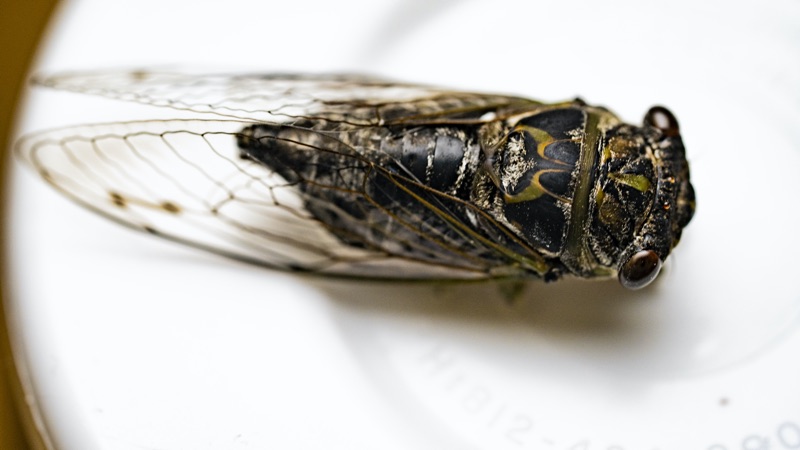
See all Neotibicen canicularis images & information on cicadamania.com.
Source: ©Insect Singers | Species: N. canicularis
Playlists contain multiple videos found on YouTube.
A. Large, heavy bodied species ; head broad, uncus simple, and first cross vein in the fore wings starting from radius 3 far back, or about one third distant from base of first marginal cell.
B. Uncus longer than broad. Black species with green or greenish markings and black area on the central part of the abdomen beneath, except in sayi, and new variety of davisi.
C. Hind margin of pronotum or collar, green or greenish.
A definite longitudinal band of black on the under side of the abdomen ; head with the front rather prominent. Not a large species canicularis (Harris).
This document compares canicularis, davisi, and aurifera. Identifying any of the green/black Neotibicen can be vexing, so these details help.
Canicularis has the central area shining black and ex- tending in the form of an irregular band to the end of the abdomen.
In canicnlaris the collar is green with its front margin often edged with black.
Family: Cicadidae
Subfamily: Cicadinae
Tribe: Cryptotympanini
Subtribe: Cryptotympanina
Genus: Neotibicen
Species: Neotibicen canicularis (Harris, 1841)
Neotibicen canicularis is one of the smaller Neotibicen. It’s better known as a Dog Day Cicada.
These photos come from a cicada hunt for auletes, but I found this canicularis as well.

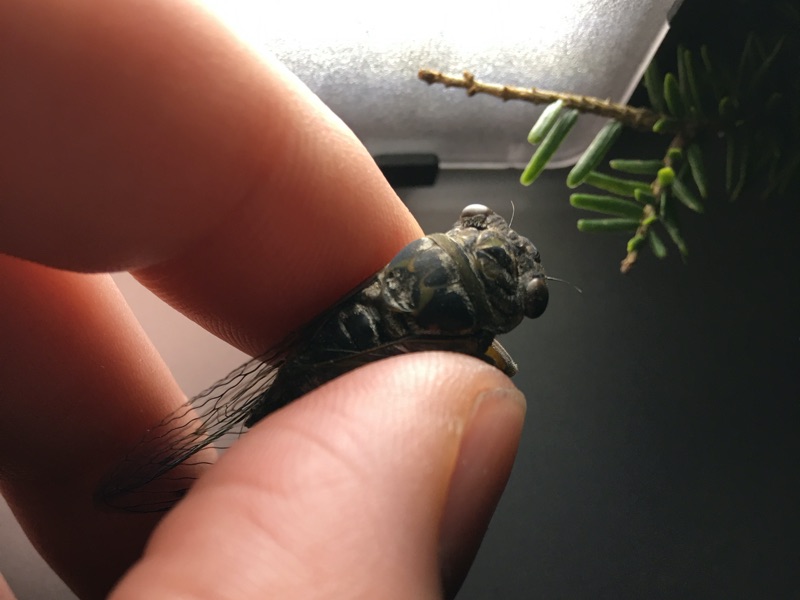
Teneral (soft, recently molted) Neotibicen canicularis (Dog Day Cicada) photos by Daniel Costa, from 2014.
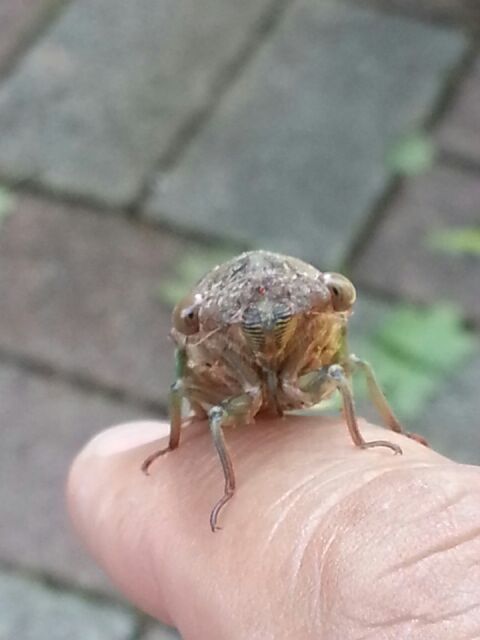
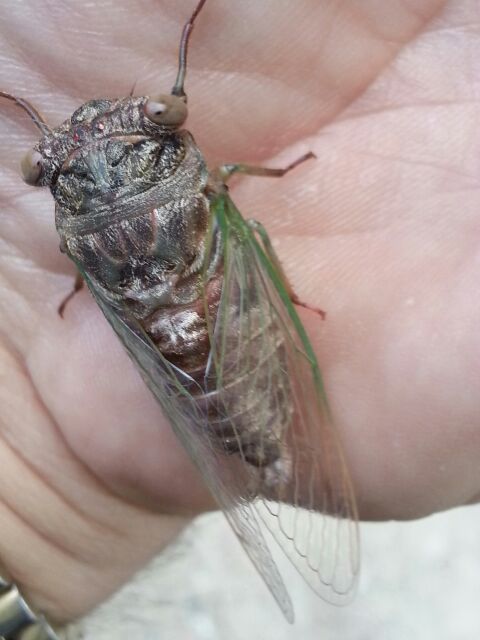
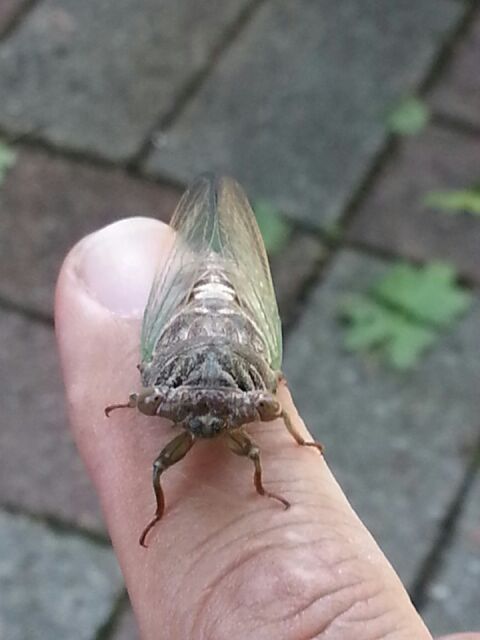
Today is September 21st, 2017 — the last day of Summer, in central New Jersey. Leaves of maple trees have started to turn scarlet and yellow. Oaks are dropping their acorns. The few, remaining Morning (Neotibicen tibicen tibicen) and Linne’s (Neotibicen linnei) cicadas sound decrepit and tired — like tiny breaking machines, low on fuel and oil. I found one dead Morning cicada lying on a sidewalk — its body crushed. Here in New Jersey, at least, the cicada season is all but over.
Molting Neotibicen tibicen tibicen in Little Silver, NJ. August 26st.
As cicada years go, this one had ups and downs. It wasn’t as awesome as 2016, but I can’t blame the cicadas.
Downs:
Ups:
Here’s some images from this summer:
Neotibicen tibicen tibicen with bad wing. The indigo color is fascinating. August 9th.
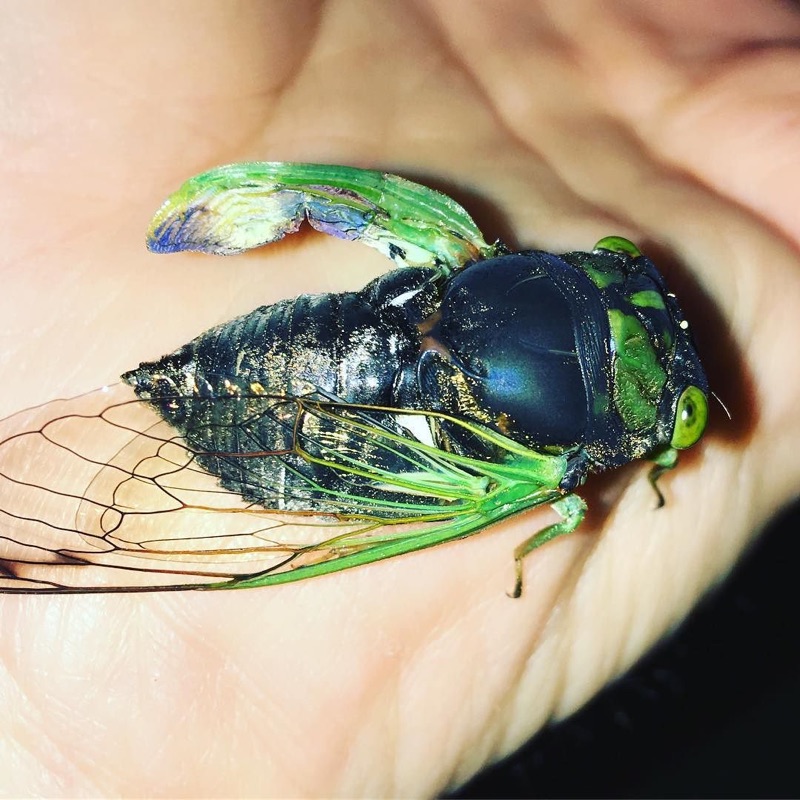
A Neotibicen tibicen tibicen found during a lunchtime stroll. September 1st.
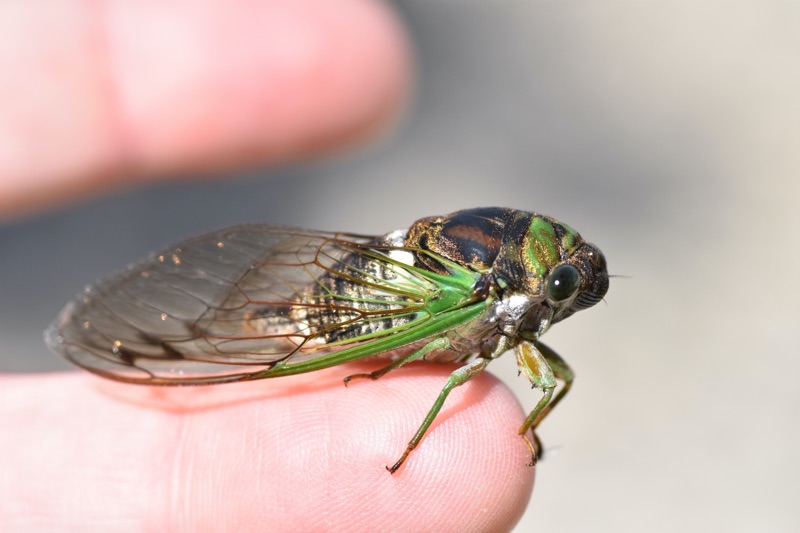
A female Neotibicen canicularis or maybe pink N. linnei found in Little Silver, NJ. August 25th.
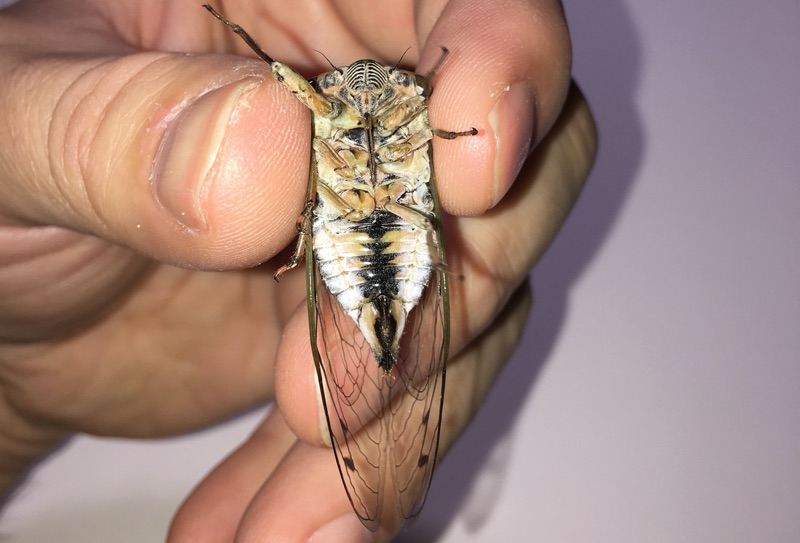
You’ll find more activity on the Facebook page, Twitter, and Instagram.
And last, the most popular post on the Cicada Mania Facebook page:
Mid-August is approaching, and the “Dog Days” of summer are almost here. Sirius (the Dog Star) and the constellation Canis Major will soon begin to appear in the early morning sky. Now is also the time that Tibicen canicularis, the Dog Day Day cicada, is also making its presence known in the U.S.A.
Edit: Dog-day cicadas (Neotibicen) are named for the time of year when the Dog-start Sirius first appears in the sky. Depending on where you are in the U.S., latitudinally speaking, Sirius should enter the pre-dawn sky between July 29th (Key West, FL) and August 15th (Bangor Maine) give or take a day.
This is a photo of a N. canicularis (Dog Day cicada) next to a T. davisi (Southern Dog Day cicada) by by Paul Krombholz:
N. canicularis has a green pronotal collar, green markings on its pronotum, and at least some, if not all, orange colors on its mesonotum (where the M is on the cicada’s back). N. canicularis sounds like (to me at least) a circular saw buzzing through a plank in wood in a neighbor’s garage.
Imagine that you are a farmer waking just before dawn and seeing the first signs of Sirius, the Dog Star, and then later in the day, hearing N. canicularis singing away in the trees surrounding your fields. Those two signs signal that summer is reaching its peak, and harvest will start soon enough.
N. canicularis can be found in the following states and provinces: AR, CT, DC, IL, IN, IA, KS, ME, MB, MD, MA, MI, MN, MO, NE, NB, NH, NJ, NY, NC, ND, NS, OH, ON, PA, PE, QC, RI, SC, SD, TN, VT, VA, WV, WI.
Here is a screen capture of the computer app Stellarium, with Canis Major and Sirius rising above the horizon before dawn.
If you’re interested in stars, check out Stellarium. It is free.
Visit the Songs of Insects site for a nice photo and sound file of the Dog Day cicada. Also by their book Songs of Insects – it is inexpensive and comes with a CD.
Patrick Farr sent us this cool picture of two adult cicadas climbing on his hand. They’re Tibicens, but I’m not sure of the species.
Gerry Bunker said in the comments that this is likely a T. canicularis.

Paul Krombholz has an interesting question about Neotibicen identification.
In Kathy Hill’s picture of 18 species, T. canicularis looks quite different from T. davisi, but I have at least one T. davisi, captured in my back yard, that looks very similar to three canicularis individuals I caught in Northern Illinois a couple of weeks ago. The canicularis individuals all have the white “hip” spots and none of my davisi have them have them. T. davisi has a slightly larger head. The big question is, What features reliably distinguish the two species considering all the variety seen within species?

Cicada researcher Kathy Hill took this unbelievable photo of 18 different USA Neotibicen & Megatibicen specimens, plus a Quesada gigas (upper right) for comparison.
Click/tap the image for a much larger version. Contact Insect Singers for more information about the image.
I just took a photo of all the “eastern USA” Tibicens except
latifasciata, which we haven’t got yet (I didn’t include the “little
western” Tibicens like T. texana that are more centrally located
either). But I did also add T. duryi from the west coast and Q.
gigas, just for comparison.I just wanted to prove that auletes IS the biggest USA cicada 🙂
Note that the these cicadas were reorganized into two new genera: Megatibicen (larger USA Tibicen) and Neotibicen (smaller USA Tibicen) since this original announcement in 2006.
* Note as of 2023 the name of this cicada has changed to Megatibicen grossus. You can also call it a Northern Dusk-Signing Cicada. Cicada names change a lot.